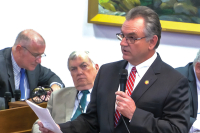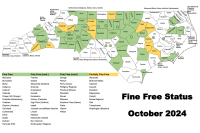Urban areas to steal more seats in Raleigh, leaving the mountains with less
Urban areas grew at a torrid pace over the past decade — so get ready, legislators in the mountains and on the coast, because your already large districts are about to expand.
Why? Because, as Christopher Cooper, a political science professor at Western Carolina University explained, even though there are very few rules about exactly how voting lines are drawn, there are two guiding principles.
First, lines cannot be drawn with race as the predominant factor; and secondly, there should be approximately the same number of people in each district.
Since urban areas grew faster than rural ones, that must be represented when lines are redrawn, said Cooper, who oversees a university-sponsored blog focused on North Carolina politics.
The state, as a whole, grew more than 18 percent. Much of that population surge occurred in Mecklenburg and Wake counties, and in those counties abutting them. Northwest North Carolina also experienced strong growth. These places are entitled to more representation in Raleigh beginning in 2012, while rural counties in WNC will get less.
“Since we hold constant the number of representatives in Raleigh, then those additional seats (for urban areas) have to come from somewhere,” Cooper said.
Related Items
Voting districts in the mountains will expand to take in larger geographic areas, freeing up legislative seats for faster-growing urban areas.
Rep. Ray Rapp, D-Mars Hill, serves on the House Redistricting Committee. He said it’s too early to know exactly how mountain and coastal districts will expand, but the shifts must take place. Western North Carolina is bounded by three states, so expansions must flow eastward: Tennessee, Georgia and South Carolina are unlikely to look favorably on a land and population grab.
That, Rapp said, will setup an eastward district-redrawing cascade of sorts. The veteran legislator emphasized that he doesn’t expect mountain dwellers to experience nearly the redistricting changes eastern North Carolinians can anticipate. Some counties on and near the coast saw population declines.
WCU Professor Cooper said residents in the state’s westernmost counties aren’t likely to look on changes favorably.
“Folks in the west have long felt that their voices are not heard in Raleigh and any change in the number of representatives we receive will only further erode trust in state government,” he said. “This is not only a North Carolina phenomenon — the farther you get from the capital, the lower the information about state politics and the less trust people have in their state government.”
Jim Davis, R-Franklin, a newly elected member of the N.C. Senate, isn’t particularly worried, though his analysis of the 2010 census data indicates the 50th District he represents will grow larger, despite already spanning parts of eight counties.
“It will have to expand quite a bit,” Davis said.
The Franklin orthodontist said he doesn’t view a larger district as a hindrance. Additionally, Davis described the state’s eastern legislative delegation as “kindred spirits” to those who represent the west. Much of North Carolina is rural, Davis said, and that creates commonalities transcending simple geography.
U.S. congressional districts, too, must reflect the population shift in North Carolina. But, in that those districts are so large already, changes are unlikely to seem as profound. Andrew Whalen, senior advisor for U.S. Rep. Heath Shuler, D-Waynesville, said prior to the census-data release he expected the congressman might pick up a few counties to the east.
Redistricting, required by federal law every 10 years when updated census data is released, comes as Republicans have grabbed control of the General Assembly for the first time in more than a century. Previous redistricting in North Carolina proved acrimonious, with Republicans accusing then-in-power Democrats of drawing the lines to their political advantage, or gerrymandering districts.
District maps were redrawn three times in as many years from 2001 to 2003 because of Republican-filed lawsuits; primary elections were delayed twice as a result, in 2002 and 2004.
Sen. Bob Rucho, R-Mecklenburg, the Senate Redistricting Committee’s chairman, says the GOP will draw districts correctly and fairly. Redistricting meetings get under way next week.
Time to redraw
The General Assembly is required to redraw voting districts for North Carolina after every census. Once adopted, a valid redistricting plan cannot be changed during that decade.
The 170 legislative districts for the N.C. Senate and House, and the 13 U.S. congressional districts, must be exactly or nearly equal in population — ensuring equal representation under the principle of one person, one vote. As the population grows, voting districts likewise must include more people.
Each representative in the N.C. House will represent about 79,500 people; state Senators about 191,000 people. Each congressional district must have 733,500 people. The redrawn districts take effect starting in 2012.









